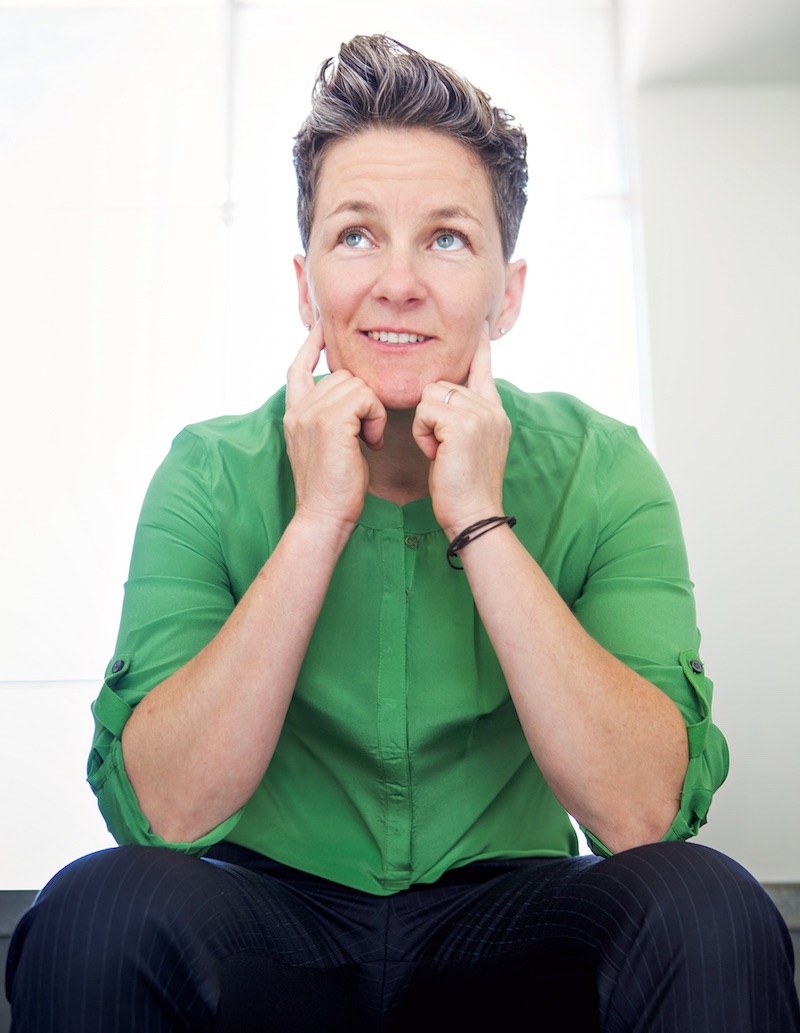A Champion for Diversity
A continuing education course aims to train occupational therapists to better provide care to LGBTQIA individuals.
By Karrie Kingsley MA ’01, OTD ’07
With four years of experience as a clinical occupational therapist, Tanya* felt confident walking into almost any situation at her inpatient rehabilitation facility. But this day was different. Tanya would be evaluating a new patient, Jennifer, a transgender female who was unable to undergo gender-affirming surgery due to extenuating medical complications.
“It wasn’t her transgender identity that was confusing for me — I consider myself supportive of LGBT people,” Tanya said. “But nothing in my training prepared me for Jennifer’s unique circumstances.”
Jennifer wanted nothing more than to be discharged home and was referred to occupational therapy for self-care education, including learning how to place her own urinary catheter.
“The nurses told me Jennifer was being difficult and refusing to address this important part of her care,” Tanya continued.
Through an open, though somewhat uncomfortable discussion, Tanya learned that Jennifer absolutely refused to touch her own penis, an essential step of the self-catheterization process. Upon this discovery, Tanya realized she had much more to learn to provide effective, client-centered care to Jennifer.
“Jennifer is a woman, and as such, the notion of acknowledging her penis as part of her anatomy was unthinkable, a betrayal to the core of her gender identity,” explained USC Chan student Joe Ungco MA ’16.
At April’s American Occupational Therapy Association conference in Chicago, I joined Ungco and a team of USC Chan students and alumni to lead conversations, which included Jennifer’s and Tanya’s scenario, during our continuing education course “Promoting LGBT Inclusivity in Occupational Therapy.” Joining us on the podium were Bryant Edwards MA ’05, OTD ’06, Elizabeth Goo MA ’15 and Michael Gragnani MA ’14, OTD ’16.
We designed our presentation to introduce and define LGBTQIA — the acronym for Lesbian, Gay, Bisexual, Transgender, Queer, Intersex and Asexual — identities, to describe health care disparities impacting this community and to identify easy-to-implement strategies that can enhance inclusive and affirming clinical encounters in any practice setting.
The experiences of attendees ranged widely — from members of the LGBT community to informed allies to people with little previous experience interacting with LGBT people — and fostered a lively open forum of shared reflections on clinical situations, including personal stories from within the profession, some of which unfortunately depicted a perception of marginalization.
For example, Ungco shared a story on behalf of a transgender male occupational therapy student at another institution.
“In class, they had an ethical dilemma assignment, and the prompt was simply, ‘You are working with a transgender woman and you feel uncomfortable; what do you do?’” Ungco recalled. “My friend was appalled that the entirety of this ethical scenario was framed around discomfort with trans people and, more so, that his classmates responded negatively. Yet the worst part of this story was that the professor seemed to support the students’ responses.”
From my perception, such a classroom scenario was not perceived to be safe. As a faculty member, I especially have an obligation to create and protect safe learning environments for all students, but it also speaks more broadly to the climate in our profession.
Scarce literature exists within occupational therapy and occupational science publications specific to the needs of LGBT clients, the experiences of LGBT clinicians and best practices for promoting LGBT inclusivity. According to a 2008 survey of 373 Midwestern occupational therapists published in the Journal of Allied Health, 64 percent of respondents reported receiving no education regarding LGBT issues during their schooling.
LGBT individuals often avoid routine health care as a direct result of negative experiences, oppression and discrimination by providers and the greater health care system. This disparity between occupational therapy’s principle of client-centered practice and inadequate training on LGBT-specific health needs inspired our USC Chan team to develop this continuing education course to better serve this population.
With an overwhelmingly positive response from attendees, we look to continue providing education and training on occupational therapy’s role with LGBT individuals and hope to put USC at the forefront of this important clinical area.
The more time I spend researching and engaging with others regarding LGBT issues and the occupational therapy profession, the more I am convinced of its importance. My colleagues and I have realized our responsibility and pledged our commitment to illuminate these complex, important and often overlooked aspects of comprehensive care.
Everyone makes mistakes related to client care. The issue with respect to the LGBT community is that, because of these mistakes, they may not continue to seek care. As occupational therapy faculty, students and clinicians, how we correct our mistakes while simultaneously striving to become more client-centered is what matters most.
*Tanya’s name has been changed for this article.
Strategies for Inclusion
Strengthen your capacity to provide inclusive, client-centered care to LGBTQIA individuals with these guidelines:
Interacting with clients
- Avoid assumptions, for example, by asking “Do you have a partner or spouse?” rather than questions about “husband” or “wife.”
- Ask open-ended questions such as “Who do you live with?” rather than “Are you married?”
- Only ask personal questions that are directly relevant to delivery of care.
- When in doubt, ask a client how they prefer to be identified.
Working with families
- Respect the client’s definition of family rather than imposing your own.
- Recognize that household division of labor may not follow traditional gender roles.
Workplace/coworkers
- Avoid gossip regarding an individual’s orientation or gender presentation.
- Avoid jokes or inappropriate language.
Faculty/education settings
- Create and protect safe spaces for learning. Use inclusive and affirming language. Represent LGBT individuals in case scenarios.
- Teach students how to be responsive, rather than reactive, to LGBT individuals.
Environments
- Incorporate inclusive materials such as pamphlets, resources and patient rights statements that include LGBT people.
- Post symbols indicating “Safe Zones” or “LGBT trained clinicians.”
⋯







